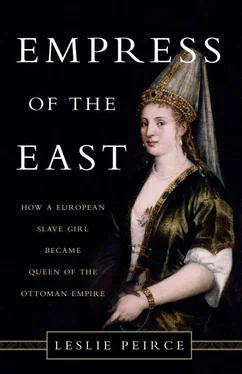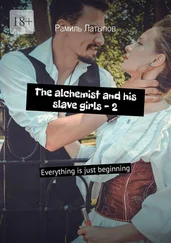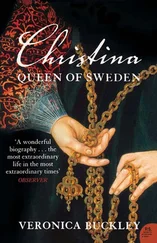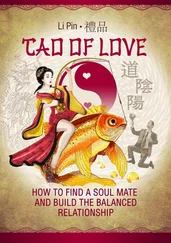Iranian campaign, 260–261
provincial post in Konya, 241
public career, 247–248
question of succession, 297–299
Bayezid I, 43, 117, 198–199
Bayezid II, 45, 85, 86(fig.), 185, 215, 220, 231, 233, 239, 253, 254, 276, 302
Byzantine forum project, 174–175
concubines’ philanthropic works, 87–88
empire building, 10
family and tragedies, 87
hospital construction, 266
overthrow of, 63, 236, 276
Beyhan (Suleyman’s sister), 38, 168, 193, 208, 250, 307
Blue Mosque, 313
Bodin, Jean, 163–164
Boleyn, Anne, 8, 41,171
Bona Sforza, 224–225, 251
Bozdağ, 226, 230–231
Branković, Mara (stepmother of Mehmed II), 199–200
Bursa, 85–87, 196, 198, 230–231, 237–239, 271, 305–306, 310
Busbecq, Ogier Ghiselin de, 118–119, 147, 199, 245–246, 274, 287–288, 298–299, 306–307
Byzantine empire, 10, 14, 18, 71, 124, 133,174, 194, 214, 231, 291, 313
Caesar, Julius, 153
Cairo, 10, 66, 86, 96, 154, 203, 207, 262
caravanserai, 47, 88, 231, 239, 289
Catherine of Aragon, 8
Celalzade Mustafa, 113, 161, 206, 280, 293
charitable foundations, 4, 9, 11. See also philanthropy
Charles V (Holy Roman Emperor), 73, 103, 159–160, 163, 167, 218–219, 224, 292
charter deeds, 178–179, 189–190, 267
children
concubinage traditions of, 6, 44–45
death of Suleyman’s, 53, 60–61
ending reproductive responsibilities, 111–113
importance of multiple children, 61
of Christian captive females, 4–5
royal concubines’ responsibility in bearing, 32–33
Suleyman’s, 35–36, 72
See also Bayezid (son); Cihangir (son); Mehmed (son); Mihrumah (daughter); Mustafa (Suleyman’s son); Roxelana, children of; Selim (son)
Chinggis Khan (Genghis), 17–18, 215
Christianity, 9, 24, 43, 48, 78, 158, 199, 213, 227, 238, 267, 290
Hagia Eirene, 49(fig.), 50, 266
Hagia Sophia, 48–50, 94, 194, 266, 313
Roxelana’s background, 4–5
royal philanthropy and, 185, 289–294
Suleyman’s religious policy, 292
and Roxelana, 192, 229, 292
Cihangir (son), 280–281
birth of, 72, 111, 113
circumcision celebration, 204–205
concerns over Suleyman’s health, 247
death of, 281, 285, 287
domestic arrangements, 210–211
ill health of, 141–142, 267, 276
political responsibilities, 243–244
question of succession, 276, 297
travels through Anatolia, 238
circumcision of the princes, 102–108, 112–113, 204–205
civil war among the princes, 167, 276–278
Cleopatra, 8
clothing, 56(fig.), 56–57, 75, 75(fig.)
Column of Constantine, 47–48
concubines
emancipation of concubine mothers, 119
foreign fascination with the Ottoman court, 40–41
justifying serial concubinage, 60
mental and physical characteristics of, 32–33
origins of, 14–15
philanthropic works, 86–87
physical and intellectual requirements, 6–7
separate apartments for chosen women, 45–46
Suleyman’s household, 36
See also Hafsa (Suleyman’s mother); harem, imperial; Mahidevran (concubine); slaves
Constantine I, 47–48, 174, 290–291
Constantine XI, 48, 200
contraception, 58–59, 111–112
correspondence between Suleyman and Roxelana, 283(fig.)
news from the war front, 282–284
Crimean Khanate, 16–17, 20–21, 25, 34, 65, 107, 219
Cromwell, Thomas, 153
Customs of the Janissaries of the Imperial Household, 240
death
of Hafsa, 113
of Mehmed, 233–237
of Roxelana’s children, 72, 305–306
of Selim I, 93–94
of Suleyman, 309–310
of Suleyman’s children, 53–54, 94, 111, 271–272, 281
of princes, 85–87
Roxelana’s concerns over internal dissent, 275–276
Roxelana’s declining health and, 12, 281–282, 299–300, 302–304, 315
visiting shrines and tombs, 227–229
See also executions
Dernschwam, Hans, 162, 184, 186, 299
dervishes, 47, 144, 152, 187, 194, 215, 228(fig.), 230, 280
See also sufis
diplomacy
Franco-Spanish conflict, 221–222
Gritti’s contribution of service, 158–159
Safavid peace with the Ottomans, 295–296
treaties with Iran and the Hapsburgs, 286–287
with Poland, 253–254
women’s role in, 11, 251–252
Divan Hall, New Palace, 131–133, 190, 255
Divan. See Imperial Council
Diyarbakır, 149–150, 200, 206, 222–223, 250, 259, 274, 285–286
domestic life, Roxelana’s, 10–11, 210–211, 225–226, 307–309
Dulkadir dynasty, 107, 198
dynastic security
educating the princes, 218–219
mothers’ role in, 315–317
multiple children securing, 60–61
See also succession
Ebu Suud, 126–127, 192, 302
education
benefits of Roxelana’s foundation, 173
boys’ seminary at the New Palace, 135
choosing the mothers of princes, 20
Haseki Avrat, 174–175, 190–191
of concubines in the Old Palace, 39, 41
of imperial princes, 84–85, 218–219
of Mustafa, 95
of Roxelana after Mehmed’s birth, 58
of Roxelana’s children, 11, 78, 82–83, 204
of slave women, 31–32
Roxelana’s conversion to Islam, 33
teachers at the Haseki Avrat, 180–181
Egypt, 8, 10, 19, 66–68, 71, 86, 96, 107, 135, 155, 219, 262, 294
England, 38
Anglo-French alliance, 102–103
foreign fascination with the Ottoman court, 40–41
Roxelana’s diplomatic relations with, 251–252
securing the dynasty, 61
women’s diplomacy between the Ottomans and, 296–297
epidemics, 36, 53–54, 82, 90, 209, 233
Ertugrul, 18–19
eunuchs, 28–29, 47, 124–125, 124(fig.), 125, 183, 315
Evliya Çelebi, 22–23, 172
executions
Bayezid (son)
Ferhad
Ibrahim, 150–154, 160–163
Iskender, 160–161
Kara Ahmed, 294–295
Mustafa, 271–279
expansion of the Ottoman Empire, 10–11, 145, 163–164
family planning, 111–112
Fatima (daughter of Prophet Muhammad), 113, 293
Fatma (Selim I’s daughter), 207–208
Ferdinand (archduke), 73, 101, 162–164, 184, 205, 218, 222–224, 286–287
Ferhad (Suleyman’s brother-in-law), 38, 71, 168, 193, 208, 250
Festival of the Sacrifice, 139
Field of the Cloth of Gold, 102–103
finances
bathing facilities, 142
charter for the Haseki foundation, 178–181
concubine mothers’ philanthropic roles, 86–87
costs of the Imperial Council home, 131
mapping the princely household, 84
revealing court practices, 88–90
Roxelana’s daily stipend, 77–78, 242
Rustem Pasha’s frugality, 251, 268–269
the vizier’s income, 155–156
fire, 121, 203, 212–213, 258
Forum of the Bull, 174
foundations. See philanthropy
France
conflict on multiple fronts, 221–222
marriage connections to the Ottomans, 14
foreign fascination with the Ottoman court, 40–41
French ambassadors, 14, 129, 140, 210, 221, 261, 300
French-Ottoman alliance, 221
Francis (king of France), 14, 40, 102, 196, 213, 221
fratricide, 7, 64, 304
Genoa, 3–4, 16, 24, 39, 45, 146, 197
Giray Tatars. See Tatars
gout, Suleyman’s, 246, 282, 300
governance
Divan days, 130–131
domestic effect of strong empire building, 304
Egyptian revolt, 71
female monarchs, 315–316
intelligence gathering, 11
in Suleyman’s absence, 117, 138–139
Mustafa’s governorship, 108–109
Читать дальше












